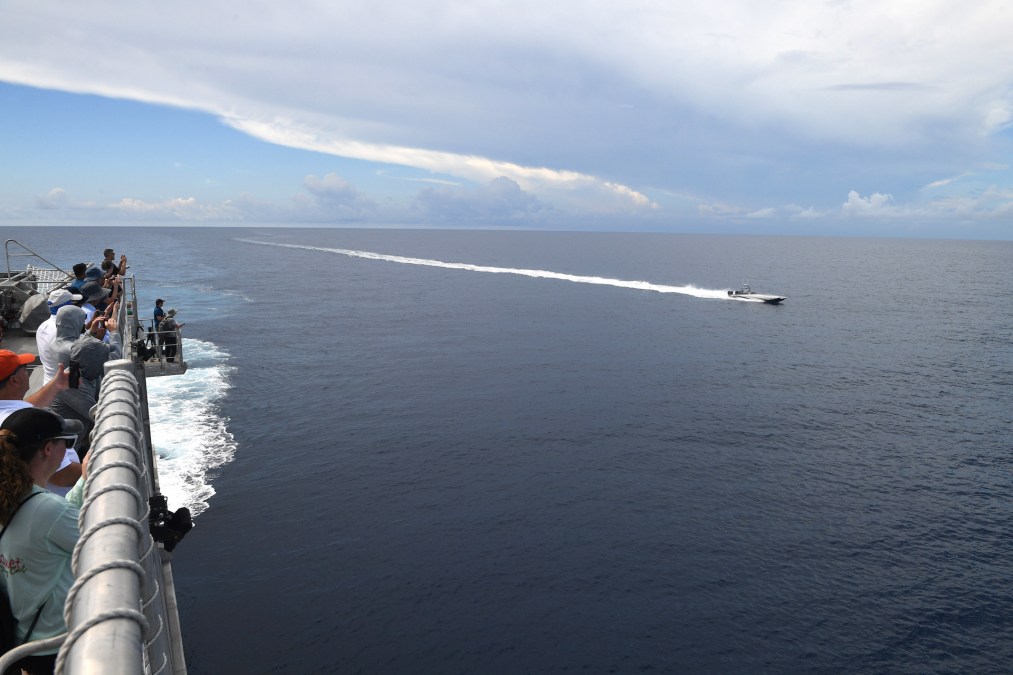DIU shopping for autonomous robo-boats with swarming capabilities for US Navy

The Pentagon’s Defense Innovation Unit issued a new solicitation to industry for autonomous maritime drones that can operate in packs to monitor and intercept adversary ships.
DIU is on the hunt for low-cost platforms that could go into production next year. The aim is to build 10 or more systems per month, which would be an annual production rate of 120 or more robo-boats.
“The Department of the Navy has an operational need for small Unmanned Surface Vehicle (sUSV) interceptors, capable of autonomously transiting hundreds of miles through contested waterspace, loitering in an assigned operating area while monitoring for maritime surface threats, and then sprinting to interdict a noncooperative, maneuvering vessel. Interceptors will need to operate in cohesive groups and execute complex autonomous behaviors that adapt to the dynamic, evasive movements of the pursued vessel,” according to the solicitation.
The Defense Department wants robotic systems that can sail 500-1,000 nautical miles in moderate sea states; haul a payload of 1,000 pounds using diesel fuel; loiter for “several days” while conserving sufficient fuel to return to base; and “sprint” at 35 knots or faster in low sea states.
Other primary focus areas include sense-and-avoid technology that can effectively operate in low-visibility conditions and in areas where global navigation satellite systems are denied; tech that enables maritime drones to autonomously shadow and intercept a vessel of interest; and “collaborative multi-agent autonomy solutions” that allow for the integration of third-party software and hardware.
Among other “highly desired” attributes for the robo-boats is the ability to carry and launch small unmanned aerial systems that could provide additional eyes to look for objects of interest.
To promote stealthiness, DIU is interested in uncrewed platforms that can “automatically adjust emissions control (EMCON) posture when in the vicinity of specific vessels and aircraft, or in specific geographic areas” and “search for, localize, shadow, and intercept a noncooperative, maneuvering vessel of interest using techniques and sensor modalities that minimize probability of detection,” per the solicitation.
For communications, the organization seeks systems that are resistant to radio frequency jamming and use a variety of pathways such as high-bandwidth commercial satcom, 5G and others.
It envisions machine-to-machine data links and mesh networks that enable “collaboration with proximate sUSVs and other unmanned systems, as well as for status reporting with a distant operations center or control station … with minimal track splitting or false positives,” according to the request for solutions.
The Pentagon is keen on using machine learning technologies that can recognize objects and assist with intelligence-gathering, data analysis, or targeting. The DIU solicitation noted that desired attributes for the small USVs include automated recognition tools “for classifying and identifying surface vessels of various types, to include recognition of hull shape, superstructure, masts, and hull markings such as letters and numbers.”
The department also wants robo-ships that can carry a variety “effectors,” per the solicitation. The term “effectors,” in U.S. military parlance, generally refers to weapon systems.
The Navy’s Task Force 59, which is under 5th Fleet, has been using commercial USVs and AI capabilities for intelligence, surveillance and reconnaissance purposes in operational environments in the Middle East region.
The unit has also been testing the ability of maritime drones to employ weapons. During an exercise in October of last year, it used an unmanned surface vessel to launch loitering munitions against a target boat.
4th Fleet, which operates in Central and South America, has also been experimenting with these types of capabilities as part of its hybrid fleet exercises.
Through the new solicitation, DIU could facilitate a major ramp-up in the Navy’s employment of maritime drones and autonomous systems.
The innovation unit, which is headquartered in Silicon Valley, works to connect the Pentagon with nontraditional contractors and commercial technologies that have military applications. It also aims to move faster than traditional Defense Department acquisition processes, via what it calls a commercial solutions opening, to get companies on contract quickly and move forward with prototyping.
“The Department intends to swiftly prototype and demonstrate one or more sUSV interceptors, aligned with robust commercial capacity to manufacture and deliver these sUSVs at scale,” the solicitation states. “After Government reviews and evaluations are complete, the Government intends to recommend specific pairing arrangements between the selected sUSV interceptor solutions and the selected collaborative multi-agent autonomy solutions.”
Proposed solutions may be expected to appear on a test range as early as 30 days after award of a prototyping agreement, for performance assessments and demonstrations of sense-and-avoid capabilities and autonomous intercept, according to the solicitation.
A follow-on production contract or transaction may be issued by one or more organizations within the Defense Department without further industry competition, it noted.
Systems need to be ready to move into high-rate production beginning in spring 2025, per the solicitation.
Responses from industry are due Feb. 12.



